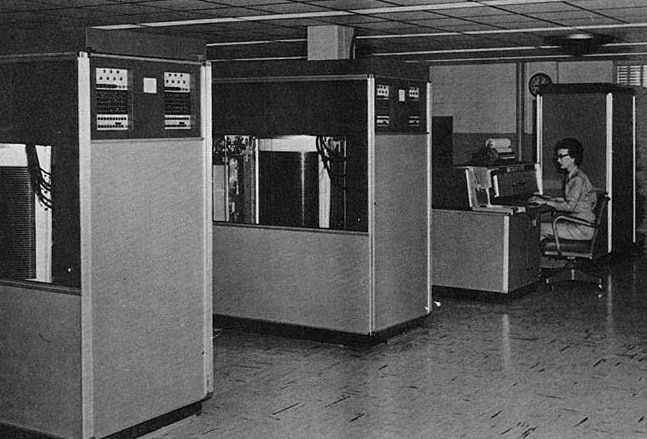It took 51 years before hard disk drives reached the size of 1TB (terabyte, i.e. 1,000GB). This happened in 2007. In 2009, the first hard drive with 2 TB of storage arrived. So while it took 51 years to reach the first terabyte, it took just two years to reach the second.
Fast forward 10 years, and in 2019 the largest commercially available HDDs can store at least 15TB of data. The world of SSDs offers even more space of at least 100TB.
This article looks back at how hard disk drives have evolved since they first burst onto the scene in 1956. We’ll examine the radical changes over time for three different aspects of HDDs: size, storage space, and price.
Changes in Physical Size Over Time
The first hard disk drive, like so many innovations in computing, came from IBM. It was called the IBM Model 350 Disk File and was a huge device. It had 50 24-inch disks contained inside a cabinet that was as large as a cupboard and anything but lightweight. This hulk of a storage unit could store a whopping 5MB of data.
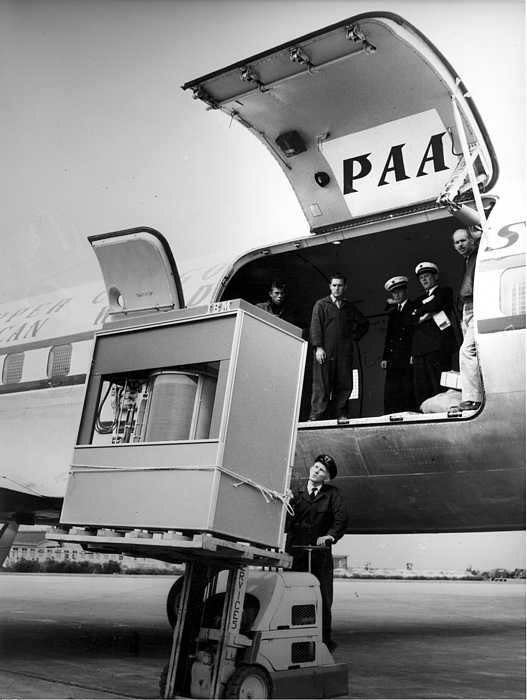
Above: An IBM Model 350 Disk File being delivered. Yes, that’s ONE hard disk drive unit.
Although hard disk drives kept improving, state-of-the art disks were built according to the concept “bigger is better” well into the ‘80s. Hard disk drives were normally used together with big mainframe computers, so this wasn’t such a big deal. Entire rooms were already set aside for the computers.
Case in point, here below is a 250MB hard disk drive from 1979.
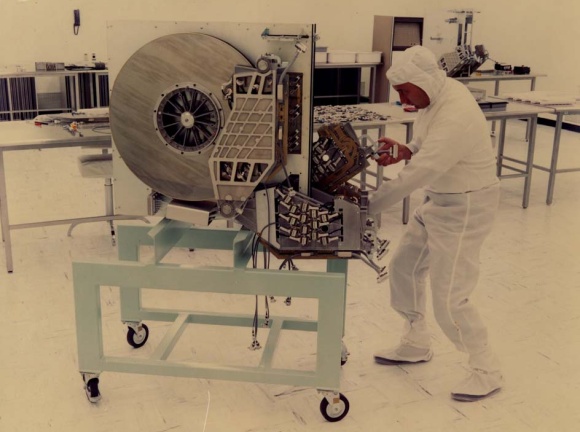
Above: State-of-the-art hard disk drive from the ‘70s.
IBM introduced the first hard disk drive to break the 1GB barrier in 1980. It was called the IBM 3380 and could store 2.52GB (“2.52 billion characters of information,” according to IBM). Its cabinet was about the size of a refrigerator and the whole thing weighed in at 550 pounds (250 kg). It gave users rapid access to a large amount of data, thanks to transferring information at three million characters per second.
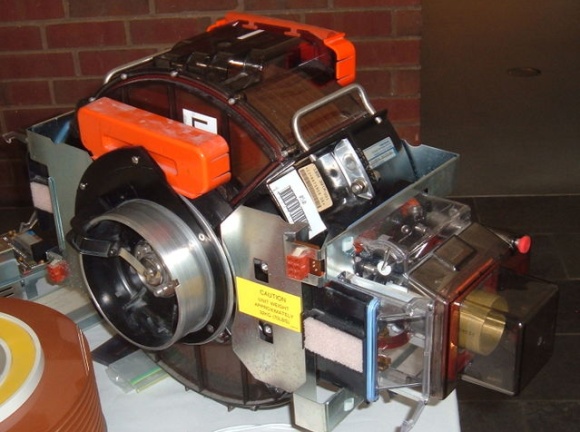
Above: The disk drive module of the IBM 3380.
Early in the ‘80s, after the first microcomputer Altair 8800, smaller “consumer” hard disk drives designed to be used with the increasingly popular personal computers (now known as PCs) started to appear. The earliest drives installed in these machines, available since 1980, were 5MB in size and had a form factor of 5.25 inches (Seagate ST506).
For a visual on how hard disk drive sizes have changed since the ‘80s until today, have a look at the below image with an old 8-inch drive all the way down to today’s 3.5-inch, 2.5-inch, and 1.8-inch drives.
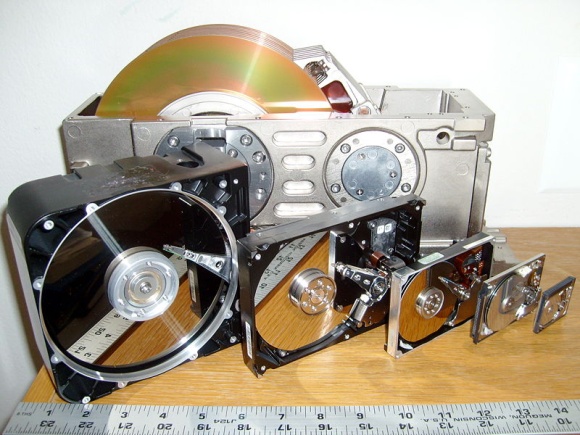
Above: Three decades of shrinkage.
Changes in Storage Space Over Time
The first hard disk drive (RAMAC 305 produced by IBM) back in 1956 could store 5MB of data, which was a huge amount at the time. This is coincidentally also the size of the first “small” 5.25-inch hard disk drive that arrived in 1980. We went from needing a special room for the hard disk drive and its computer, to having one we could fit inside a desktop computer.
Ten years later, in 1990, a “normal” hard drive (like the ones produced by Maxtor) held about 40MB, with more expensive options able to store more than 100MB.
Fast forward to present day, and you can buy a 3.5-inch hard disk drive with 15TB of storage space.
To illustrate the tremendous increase in storage space we have seen in the last 38 years (essentially since the birth of personal computing), we’ve made a 1980 vs. 2010 and 2019 side-by-side comparison chart.
Note that we have used a logarithmic scale in this chart. Each step on the Y axis is 10 times larger than the one below it. If we had used a regular, linear scale, the columns for 1980 would have been less than a pixel high.

Note: To estimate the normal size HDD on the chart, we used the data regarding the average capacity of Seagate hard disk drives.
As you can see, the gap between a normal versus a top-of-the line hard disk drive in terms of storage space has become much, much smaller than in the past. Interestingly, today both maximum and “normal” storage may have the same physical size, which definitely wasn’t the case back in 1980. No one’s making those fridge-sized hard disk drives anymore.
Of course, nowadays we have special storage devices with a gazillion regular hard disk drives crammed inside that have taken over the “ridiculously expensive” crown.
And speaking of price…
Changes in Price Over Time
As with any rare commodity, early hard drives were extremely expensive and used with equally huge and expensive mainframe computers.
The first hard disk drive, the IBM Model 350 Disk File we mentioned above, wasn’t something you got as a stand-alone unit. It wasn’t even something you bought. Instead you could lease the IBM 305 RAMAC computer that came with the 350 Disk File for $3,200 per month. Back in ‘50s this was a lot more money than it is now.
The biggest and best hard disk drives kept being an expensive proposition. When it finally started selling in 1981 after some initial delivery hiccups, the price for the 2.52GB refrigerator-sized IBM 3380 started at $81,000. And then you of course needed a computer to use it with…
The first 5.25-inch 5MB hard disk drives (i.e. the consumer option) in the ‘80s cost well over $3,000. Similar prices remained for the 10MB drives that soon replaced them. This probably explains why most PCs were initially sold without a hard disk drive, instead relying on floppy disk drives.
As storage space has increased, it has also become infinitely more affordable. The average cost per gigabyte has, over the last 30 years, gone from way over $100,000 to just a few cents. Now that’s inflation…
Factoid: A 5MB hard disk drive from Apple cost $3,500 in 1981. That’s $700,000 per gigabyte.
Nowadays, we will pay around $18 for 1TB of hard disk space.
And of course, 38 years ago, TB of storage was unheard of.
A Promotion Video of the First Hard Drive
To round off this retrospective, here’s some vintage promotion material about the 1956 IBM 305 RAMAC computer and its amazing innovation, the IBM 350 Disk File. This is tech geek gold. If you can watch this without getting a smile on your face, please get some help.
Another 30 Years Into the Future
Considering we now have tiny, cheap USB sticks that can easily hold 256GB of data (and expensive ones—1TB or more), which is about 6,500 times more than a normal hard disk drive in 1990 (40MB), we can say that things have certainly moved forward.
And just like we are now looking back and shaking our heads at the amazing difference between now and a few decades ago, we may look back at 2019 and shake our heads with similar amazement. “Was storage really that primitive back then?”
Explore the History of IT With Royal Pingdom
Looking for more posts on the history of IT? Be sure to read about the history of PC hardware, as well as our hand-picked selection of early computers (1940s-1960s).
Picture Sources:
The IBM 350 Disk File from IBM via ed-thelen.org, 250 MB hard disk drive from 1979, Hard disk drives of multiple sizes by Paul R. Potts, IBM 3380 disk drive module by ArnoldReinhold (Wikimedia Commons), Closeup of HDD head by Alexdi (Wikimedia Commons), IBM 305 at U.S. Army Red River Arsenal, with two IBM 350 disk drives in the foreground.
Wikipedia was, as it so often is, a great help when checking out the facts and figures.
Note: This article first appeared on this blog back in 2010, and we have slightly touched up the content.





